The Edwardian summer girl is robust, strong and independent. She’s bare-armed, collarless, hatless and short-skirted: She doesn’t care if she gets freckles or a tan. She’s as good at sports as men: She swims, rows, hunts – she even plays barefoot golf!
Related: How To Dress In The Edwardian Era
The Edwardian Out Of Door Girl
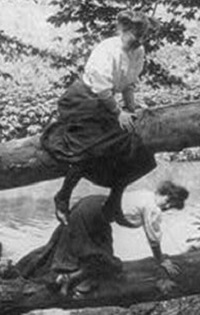 ‘The clinging ivy and the sturdy oak idea has received its quietus. The fragile woman, much adored and courted by men, is a thing of the past. Much to the regret or the men, perhaps, has all this happened. It may be that they long for the return of the gentle maiden who had to be shielded from the sun, whose most arduous exercise was riding in a victoria, who was so essentially feminine. There is no chance for a modern Sir Walter Raleigh to spread his cloak over a mud puddle for a modern queen, the queen would jump the puddle. It is distressing for the men, who, for the sake of self-respect, must be stronger and sturdier than the women. They must be the sturdy oaks even if the ivy refuses to cling. […]
‘The clinging ivy and the sturdy oak idea has received its quietus. The fragile woman, much adored and courted by men, is a thing of the past. Much to the regret or the men, perhaps, has all this happened. It may be that they long for the return of the gentle maiden who had to be shielded from the sun, whose most arduous exercise was riding in a victoria, who was so essentially feminine. There is no chance for a modern Sir Walter Raleigh to spread his cloak over a mud puddle for a modern queen, the queen would jump the puddle. It is distressing for the men, who, for the sake of self-respect, must be stronger and sturdier than the women. They must be the sturdy oaks even if the ivy refuses to cling. […]
The sweet, pale, clinging woman has disappeared. […] In her place stands a woman who is robust, independent, and fearless, and none the less beautiful because she is strong. She is as great a devotee of out of door games as the men of her family. She can go into any sport without being stigmatized by Mme. Grundy as vulgar. She can carry a rifle on her shoulder without being called mannish. She knows how to use a fishing rod.
The golf girl leads in outdoor life. In short skirt and shirt waist sleeves pushed above her elbows, hatless and collarless, she is regardless of sun and wind. She cares nothing for a few freckles and an extra coat of tan. The latter is gotten rid of all too easily. A few weeks of enforced indoor life will accomplish that.
The tennis girl is still a familiar figure on the Iawns of her country home, for the game is as popular as it was when it began the athletic girl’s career. The modern athletic girl swims, paddles her canoe, and rows. […] “Really,” said one healthy looking girl to another not long ago, “the men are getting positively rude nowadays. If you ask one to go rowing he will seat himself in the stern and naturally expect you to do all the pulling.” “You shouldn’t row so well, then,” said a masculine auditor.
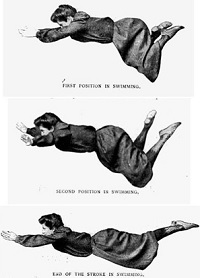 The majority of girl athletes prefer the surf bathing to a fresh water dip […] She no longer takes her perfunctory dip in the surf, but swims out some distance and then comes swimming back with long, steady strokes which bring admiration from the observers. When she reaches the shore she is not in the least tired and is quite willing to accept a challenge of any of her male friends for a race […]
The majority of girl athletes prefer the surf bathing to a fresh water dip […] She no longer takes her perfunctory dip in the surf, but swims out some distance and then comes swimming back with long, steady strokes which bring admiration from the observers. When she reaches the shore she is not in the least tired and is quite willing to accept a challenge of any of her male friends for a race […]
When fall comes and the out of door summer sports have gone, then the modern girl arises early in the morning and sets out on her long tramps. She may carry a shotgun and go unattended by her dogs to a well known covert where birds may be found […] She seldom fails to bring home the trophies of her skill’. (Chicago Tribune, August 1903)
The Edwardian Outing Girl
‘The outing girl this summer is the most favored mortal in all the world. Everything has been designed for her especial comfort, which is saying a great deal when it is remembered that for centuries on centuries the dictates at fashion have had to have solely with the lavishness of her personal adornment without the slightest consideration for her health or her feelings. […] For it is a strange circumstance, and one worth noting, that comfort has at last been placed before beauty in the very latest edict of what is proper for summer wear. […]
The new outing suit, whether it be for cycling, golfing, walking, tennis, yachting and, yes, even for bathing, must fit to perfection; and – whisper – in this fact lies the whole secret of 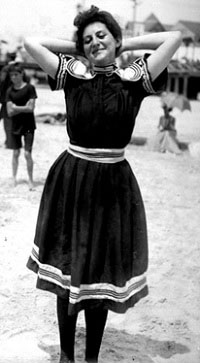 their comfort. […] For this particular kind of outing girl, who after all is the real outing girl, nearly everything this season, hats included, has been made of washable materials […] the new skirts are shorter – much shorter than last season and much more becoming garments in every way. These, however, must not be confounded with the latest pedestrian skirts of woolen cloth, which are also used for golfing. The proper length this year is two inches from the ground.
their comfort. […] For this particular kind of outing girl, who after all is the real outing girl, nearly everything this season, hats included, has been made of washable materials […] the new skirts are shorter – much shorter than last season and much more becoming garments in every way. These, however, must not be confounded with the latest pedestrian skirts of woolen cloth, which are also used for golfing. The proper length this year is two inches from the ground.
Then there are the dashing Panama hats for cycling, golfing and walking, which can be soused in the washtub, and after being hung out on the line to dry can be retrimmed as good as new. In this line the new pique caps for tennis and golfing, which can be sent to the laundry with weekly regularity, are also among the prettiest novelties. […] The new shirt waist suits may be fastened either front or back.’ (San Francisco Call, May 1902)
‘The success of outing apparel lies in a smart appearance and in becoming lines […] Cycling and golfing remain popular sports, and a costume suitable for either or both is practically a necessity. For actual service Scotch and English whipcords and homespuns in solid colors or invisible stripes, covert and Oxford suitings and mohair are also included in this line. The gray and tan shades are perhaps the most practical, but by no means are worn exclusively, as the various shades of blue and even black and black-and-white mixtures are in high favor. Costumes of this sort are usually made in the coat-and-skirt style, the former of the Eton or jaunty reefer type and the latter of gored shaping, in instep or comfortable walking length.
Linen, crash, duck, piqué, Galatea and mercerized goods are employed for mid-summer suits, and white, though being a most important feature. Shirt-waists of cotton cheviot, madras, linen, Panama cloth and chambray – all beautified by the mercerizing process – are worn with both the cloth and wash suits, and in the latter they are frequently of the same material, contrast being achieved by the stock and belt that are essential accessories to all Summer dresses. Ginghams in the fine zephyr weaves, in polka dots and stripes, also make particularly attractive shirt-waists for outing wear.
Cream-white serge, mohair and flannel are the fabrics best liked for boating or yachting suits, and when trimmed with contrasting color, silk or cloth, or white mohair or wool braid, they are charming. These materials are also extremely popular in royal and navy blue and may be brightened by hands of white or scarlet.’ (The Delineator, 1902)
The Edwardian Shirtwaist Girl
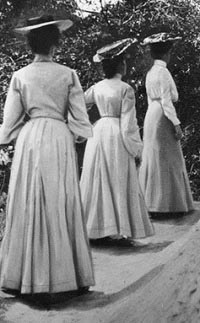 ‘She wears three kinds of shirt waists […] the fluffy lawn waist, the very elegant silk and chiffon waist, and the waist that is made of linen and cut severely like the waist of a golf suit’ (San Francisco Call, 1903). ‘The shirt waists which are made of grass linen are exceedingly charming. […] Grass linen washes very well and wears well – better, in fact, that most other material, so that, although it is quite expensive, it is economical in the end.’ (San Francisco Call, July 1905) In the 1900s, fabric made of ramie, a type of nettle, was called “grass linen”.
‘She wears three kinds of shirt waists […] the fluffy lawn waist, the very elegant silk and chiffon waist, and the waist that is made of linen and cut severely like the waist of a golf suit’ (San Francisco Call, 1903). ‘The shirt waists which are made of grass linen are exceedingly charming. […] Grass linen washes very well and wears well – better, in fact, that most other material, so that, although it is quite expensive, it is economical in the end.’ (San Francisco Call, July 1905) In the 1900s, fabric made of ramie, a type of nettle, was called “grass linen”.
‘She has a fad for wearing a shirt waist without a collar and she loves to turn in the neck of her shirt waist. This is when she golfs. She goes without a hat and she rolls up her sleeves. This gives her an even coat of tan and makes her strong.’ (San Francisco Call, July 1904)
‘Fashionable tidings for the woman who will spend the season in a shirt waist and for the one who is not prepared to lay out a million upon this now famous little article of summer dress […] The girl of summer comes tripping toward us and it is pleasant to go out to meet her upon the way. She wears a sunny smile, as befits her mission, and an artless manner. She also wears a shirt waist. […] Hygienic, pretty, inexpensive, becoming, stylish, useful, easy to obtain; all these qualities and many more can be attributed to the summer shirt waist. It would be well if with its other unfading virtues, the shirt waist could be maintained at its original cost, which was of a dollar or less. But it has received important additions that have made it costly and it is to-day not so cheap a waist as it was. […] So very many of the waists button down the back […] The waist that buttons down the back is certainly in, and more’s the pity, for it is difficult to fasten and to the woman who lives in a hotel, it means a tip every time, quite a noticeable amount when reckoned up at the close of the season.’ (San Francisco Call, March 1902)
‘Waists that are made according to Dame Fashion’s most pronounced modes are made neckless. They have the little Dutch neck, which will permit of a stock or a bertha underneath. But the neck is finished plain and round. Or the neck can be a French neck with a tiny point in front. […] And it is still smarter to finish them with a stiff neck band with 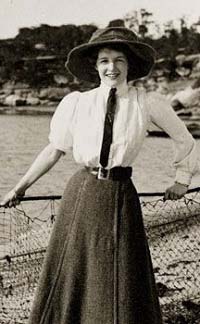 buttonholes front and back so that the new and beautiful hand embroidered linen collars carried out in Armenian combinations may be buttoned on. The new hand-embroidered linen collars show the most gaudy pinks upon them, going all the way around the collar, life-size, and finished with a bright red ribbon under the chin, to match the pinks. […]
buttonholes front and back so that the new and beautiful hand embroidered linen collars carried out in Armenian combinations may be buttoned on. The new hand-embroidered linen collars show the most gaudy pinks upon them, going all the way around the collar, life-size, and finished with a bright red ribbon under the chin, to match the pinks. […]
Wide belts, made of needlework end shaped like girdles, are worn. Immense needlework belts, two fingers deep in front and tapering toward the back, are adjusted to many shirt waists. […] Be sure to recognize the value of a smart stock and don’t try to make your shirt waists without, from one to three adjustable stocks, choosing variety in material and color. […] Have your everyday waists heavy as you can. It is smart to make them heavy and you can trust to the laundry and the wear and tear of the season to make them much lighter in weight. […] As a rule, one wears one’s shirt waists but each season. […] The remaking of the old shirt waist is a thing not to be overlooked by the one who is on economy bent and who wants a nice wardrobe on very little money.’ (San Francisco Call, March 1905)
The Edwardian Bare-Armed Girl
‘The “society girl” is no longer with us. She has been relegated to the past. It is now the smart athletic young woman – the young woman of to-day who shoots, rides, swims, goes boating and yachting and plays golf and tennis. The pink and white flowers of the ballroom have evoluted into this. Where in the old days the maiden fair donned her sunbonnet and gloves she now tears them oft, rolls up her sleeves to display a correctly sunburned arm and turns her collar down to show an equally sunburned neck. She is to be seen every day on the beaches of California, romping in the breakers; or in the mountains, swinging a team along at a lively clip. She tramps with the hounds after the deer over the ridges, or casts a fly into the shady pool as well, and often a little better, than her brothers. And as for tennis and golf— she plays them like a man. What more could be said? […]
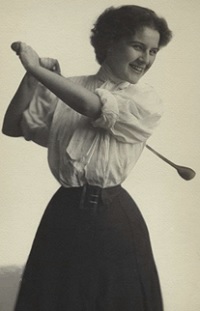 At the present day no outdoor recreation or pastime is more fashionable in the United States than golf, and nearly every lady whose husband or father is possessed of any considerable means or social importance at least feigns, if she does not feel, an interest in the royal and ancient game. […] But, to be quite comme il faut, she ought to play the noble game herself, and to be more concerned about a “topped ball” than a hat awry or a freckled face. She should don a short golf skirt, with thick flat-soled shoes, a shirt waist with the sleeves rolled up to the elbow and tramp around the links at least twice a day three times a week. It should delight her heart more to pull off a long sweet drive than to get a two pound box of candy, and she should be prouder of a pewter pot won in a club handicap than of a big bouquet of American Beauty roses from a millionaire’s son. And there are several of our fashionable girls and young matrons who really do seem to take more genuine pleasure in trudging round a links than in traversing a ballroom – who prefer golf to gossip and broad Scotch to scandal. […]
At the present day no outdoor recreation or pastime is more fashionable in the United States than golf, and nearly every lady whose husband or father is possessed of any considerable means or social importance at least feigns, if she does not feel, an interest in the royal and ancient game. […] But, to be quite comme il faut, she ought to play the noble game herself, and to be more concerned about a “topped ball” than a hat awry or a freckled face. She should don a short golf skirt, with thick flat-soled shoes, a shirt waist with the sleeves rolled up to the elbow and tramp around the links at least twice a day three times a week. It should delight her heart more to pull off a long sweet drive than to get a two pound box of candy, and she should be prouder of a pewter pot won in a club handicap than of a big bouquet of American Beauty roses from a millionaire’s son. And there are several of our fashionable girls and young matrons who really do seem to take more genuine pleasure in trudging round a links than in traversing a ballroom – who prefer golf to gossip and broad Scotch to scandal. […]
When the maiden fair decided to go in for athletics she shed her stays, threw away the sunbonnet, donned a skirt that suddenly rose from the ground to the knee and sallied forth in the long-sleeved shirt waist and high boots as the proper thing to wear in most all kinds of weather. Then came the rage to be at least three colors darker than one ought to be. […] It didn’t take long for them to understand that, be as fashionable and proper as you please, they couldn’t get a good cut at the pesky ball with two or three yards of flowing sleeves waving in the air and getting mixed up with the club and getting torn from belt buckles. Then the bravest pulled up their sleeves about an inch. It was an experiment. It worked beautifully. 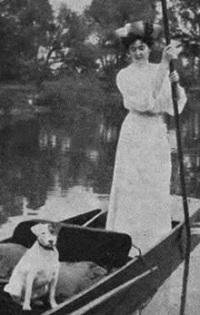 Cautiously, with considerable mental agitation, the arm was disrobed inch by inch, day by day, until one maiden, less conservative than the rest, cut away the whole bothersome thing. She found that she couldn’t be so horribly nice and hope to win the game. Society nearly had nervous prostration. People talked and talked. But when the match went down from 115 to the fifties, a mixed foursome, the bare-armed girl became the most popular pardner on the links. […]
Cautiously, with considerable mental agitation, the arm was disrobed inch by inch, day by day, until one maiden, less conservative than the rest, cut away the whole bothersome thing. She found that she couldn’t be so horribly nice and hope to win the game. Society nearly had nervous prostration. People talked and talked. But when the match went down from 115 to the fifties, a mixed foursome, the bare-armed girl became the most popular pardner on the links. […]
The girl who essayed to row found that she could bring more strength to bear on the oar and that it didn’t fly out of the water half as much if she could devote her entire attention to the stroke and not to her troublesome sleeve. Another victory for the bare arm. The tennis fiend soon found out, that a more powerful swipe could be attained minus that superfluous bit of cloth, and she promptly cut it off, tore it off, sawed it off anything, in fact, to get rid of it and win a rattling good game from some smart chap.
When the little ladies returned from the shore and tarried for a day or two they didn’t want to lose any of that lovely, becoming coat of tan which covered the face and throat, and that extended from the tips of their fingers to the bend in their elbow. They wanted everybody to see […] If they couldn’t get the proper shade by the country winds, who was to hinder them sitting in their own back yards or standing in the hot sun until they were colored to the much desired, necessary russet? […] 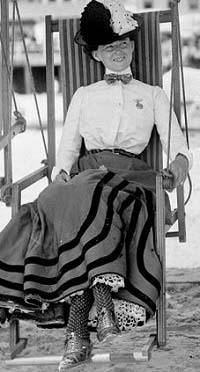 Now even the girls who are working for a living air themselves every Saturday afternoon and Sundays in the two-by-four planked yards or lie on the beach minus their hats and gloves. They swarm to the baths and play in the salt water and then dress without a shower. […]
Now even the girls who are working for a living air themselves every Saturday afternoon and Sundays in the two-by-four planked yards or lie on the beach minus their hats and gloves. They swarm to the baths and play in the salt water and then dress without a shower. […]
The bare-arm girl is seen indoors and outdoors to-day. You may find her strolling to the letterbox and even downtown shopping. She is comfortable indeed, and no man would dare to make goo-goo eyes at her. Her attire suggests that she is dying for a rough and ready fight right on the sidewalk and that she would commence at the drop of the hat. Nobody would ever dream of telling her that black was white, for she looks absolutely capable of thoroughly disputing the fact. This bare-armed lassie […] is omnipresent with her skin of tan.’ (San Francisco Call, September 1901)
Related: Staycation In The Edwardian Era
The Edwardian Short-Skirted Girl
‘She walks, drives, flirts and dances in a gown that swings clear of the ground and she wears a short skirt whether she golfs viggorously or lounges lazily under the apple trees […]
The short skirted girl of a couple of seasons past was the freak; she was the Rainy Daisy, the pedestrian girl, the mountain girl, the climbing girl. She was everything but the pretty girl. For the short skirts, as they were made then, were not pretty. […] No matter what they were called, whether they were named the rainy day skirt or the instep skirt, the shopping skirt or the ankle length, they were not the thing to invite admiration. Women wore them because they were comfortable and convenient. But because they were pretty— never! But now it is different: The swing-clear skirt no more resembles the short skirt of a few years ago […] The skirts of this season, those that are made on the new art lines, all swing clear. If they touch they are of the round length – that is, the length which just touches the floor all 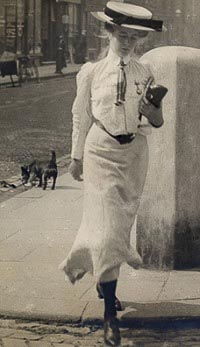 the way round; the length that is so delightful for piazza, and house wear.’ (San Francisco Call, June 1904) ‘For street, for walking, for shopping, for informal calling – indeed for all except very dressy purposes – fashion calls for the skirt that swings clear from the ground.’ (San Francisco Call, 1904)
the way round; the length that is so delightful for piazza, and house wear.’ (San Francisco Call, June 1904) ‘For street, for walking, for shopping, for informal calling – indeed for all except very dressy purposes – fashion calls for the skirt that swings clear from the ground.’ (San Francisco Call, 1904)
‘The walking, or the pedestrian, skirt is now the favorite skirt for summer excursions of all kinds. It is worn on every occasion, when the sweep skirt could not be tolerated […] Modistes will differ as to the proper length of this skirt. […] in what is called swinging length. It must swing clear of the street, but not be short enough to show the ankles. To get a skirt in this ideal length requires an ideal cut. The lower edge must be undulating and must curve from the front to the back […] This requires a high art, and to cut the skirt needs a practiced hand. A skirt properly planned will escape the floor and will set out, swing clear, while it will by no means touch at any point, nor cling to the knees. […]
It is generally agreed that the skirts in pongee and poplin may be a little shorter than the heavier ones of serge and cheviot, or the skirts of ladies’ cloth and broadcloth. Skirts of pique and duck, of linen and drill, may be nearly ankle length, but, really, there are very few that are built any shorter than this. The outing girl will find that she can run just as well in a well cut skirt of ankle length as in one to her knees’ (San Francisco Call, July 1902).
Related: Edwardian Walking Dresses
‘And speaking of swinging clear as one walks brings one with suddenness to the question of the petticoat […] all petticoats must be very full […] and they must be built to make the gowns stand out. […] in place of the crinoline, there were to be worn the handsomest petticoats that could be designed. They must be made out of good material – that is, out of silk which had some stiffening. And they must be elaborately frilled to make a frou frou around the foot. […] the petticoats of to-day are full and are made as fluffy as possible.’ (San Francisco Call, June 1904)
‘For wear under this escape-the-ground skirt there comes a little brilliantine petticoat which is only a little longer than the knees. It is not full and its only trimming is a contrasting band of taffeta around the bottom. This petticoat looks odd to the woman who has never worn it, but it is so very comfortable and so well suited to its purpose, which is that of making the pedestrian skirt hang well, that one forgets its looks.’ (San Francisco Call, 1903)
Summer Colors
‘While white leads as a summer color, the little check and the stripe will follow soon after. White canvas dresses are very pretty and they clean cheaply and easily, even if they do not wash. But if you want something in colors there are lovely plaids in blue and white that are becoming, light and very desirable.
One summer girl who tramps a little, principally in village walks, where she must look pretty, is wearing a white plaid gingham, in deep blue and white, with a check or two in light blue. The skirt barely swings clear from the ground, and it is trimmed around the foot with a wide band of blue braid, put on with several rows of white stitching. The belt is a narrow thing in dark blue leather as light as kid; and to it hangs a little blue leather fob with silver mountings and an attachment for a hand bag.’ (San Francisco Call, 1902)
Refashioned Summer Dresses
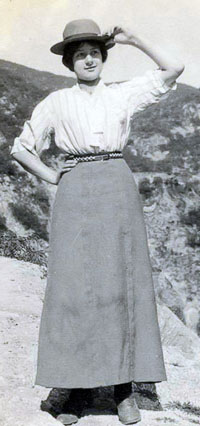 ‘The summer girl of America […] seems always gowned for the day. If it be cloudy she has her dress of English whipcord made at walking length. If dusty she is dressed in a granite suiting, neatly fitted to the hips and calculated to stand a blowing. If the clouds have burst outright she wears a storm serge in one of the new blue grays, or in a brown that will stand the weather; and if to rain and wind is added a disagreeable moistness she is dressed in deep blue brilliantine – that material that withstands everything and is good the next day. For nice days, whether traveling or walking, whether boating or driving, whether resting or picnicking, the American girl has a gown of French mistral cloth, looking a great deal like etamine, but with a little more body. And, then, she has an etamine to wear when she is more dressed up.
‘The summer girl of America […] seems always gowned for the day. If it be cloudy she has her dress of English whipcord made at walking length. If dusty she is dressed in a granite suiting, neatly fitted to the hips and calculated to stand a blowing. If the clouds have burst outright she wears a storm serge in one of the new blue grays, or in a brown that will stand the weather; and if to rain and wind is added a disagreeable moistness she is dressed in deep blue brilliantine – that material that withstands everything and is good the next day. For nice days, whether traveling or walking, whether boating or driving, whether resting or picnicking, the American girl has a gown of French mistral cloth, looking a great deal like etamine, but with a little more body. And, then, she has an etamine to wear when she is more dressed up.
None of these gowns are very costly and the chances are that the American girl has had a hand in making them herself. […] With the American girl there is no such thing as an old-fashioned dress. She is willing to alter and remake, remodel and reshape; to change and add, subtract and build, until she has something that is up to date and in keeping with the season. It is not an uncommon thing for the American girl to spend a part of her summer at the occupation of sewing. As fashions change and new styles develop she will make changes in her wardrobe and each morning sees her busy fingers at work, fashioning. […] her dress is ever new and varied […] she does not allow this devotion to style to interfere with her life. She is quick and ingenious and can do in a few moments that upon which other women would work for days.’ (San Francisco Call, 1902)
Edwardian Outing Hats
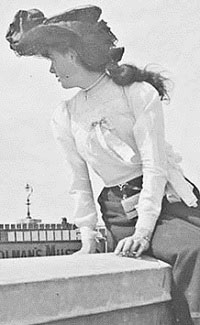 ‘No well ordered summer maided is or ever can be insensible of the virtues of the summer outing hat. […] The best outing hats are the ones that can be wet with rain, dampened with sleet, coated with road dust and stained with vagrant spots without revealing their vicissitudes to the beholder.’
‘No well ordered summer maided is or ever can be insensible of the virtues of the summer outing hat. […] The best outing hats are the ones that can be wet with rain, dampened with sleet, coated with road dust and stained with vagrant spots without revealing their vicissitudes to the beholder.’
An English outing hat, which Queen Alexandra wears for a walk in the Scottish hills or ‘when she goes out to feed her dogs […] is a ready-to-wear hat of felt, slightly mixed in gray and black, rough to the touch and trimmed with a band of gray tweed and a quill of black.’ A French outing hat is made of white felt: ‘the hat looks like a round hat. The top is trimmed with a band of white ribbon, and there is a gentlemanly little crease in the middle.
The white felt hat is a hat that is brought out every summer, and it is a hat that wears forever. Its only failing is its tendency to show spots, but as spots can be removed by judiciously application of soap and chalk and magnesia the hat remains a fixture in popular favor. […] The white felt hat is seen this year in the alpine shapes, in the round hats, in the English walking hats and in the Gainsborough designs. […]
The stiff felt hat, or the soft felt hat, as the case may be, is always a trying hat. It does not frame the face prettily and it does not lend itself to the curves of the cheek or the contour of the forehead. On a very pretty young girl it is all right, but it is not becoming to the more mature woman, nor to her whose type is irregular and whose coloring is not clear.’ A felt hat can be ‘trimmed around the edge with a scarf’ or ‘a few dangling wisterias or a bunch of the ubiquitous grapes. Or it may be a few roses fastened at the back or the hat or some carnations arranged so that the buds and the leaves touch the neck. But something positively must dangle. And, be it an ostrich feather, a gay flower or lace ends, one will surely see some little indication that the rear end decoration is still the style. The severe types of outing hats do not have their dangling ends. But there are many hats that are trimmed with scarfs, decorated with velvet bows or touched with streamers of flying lace. […]
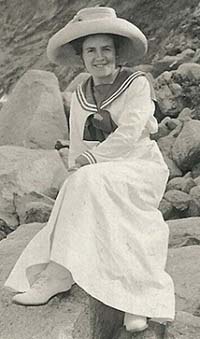 The lace trimmings are seen not so much upon the actual outing hat as upon the piazza hat. And this is one of the prettiest of all ways to trim this hat. The piazza hat, made of chiffon or of straw and treated to a top of flowers, is delightfully finished if its edges be veiled with lace. To arrange a lace scarf around a hat, be sure that the scarf is long and that its ends are cut in points, as these make the prettiest streamers imaginable. Now fasten the lace scarf around the hat brim in folds, letting the folds cover the top of the hat if they will. The lace will fall over the ledge, just touching the hair, and making a frame for the face that is as bewitching as can be. […]
The lace trimmings are seen not so much upon the actual outing hat as upon the piazza hat. And this is one of the prettiest of all ways to trim this hat. The piazza hat, made of chiffon or of straw and treated to a top of flowers, is delightfully finished if its edges be veiled with lace. To arrange a lace scarf around a hat, be sure that the scarf is long and that its ends are cut in points, as these make the prettiest streamers imaginable. Now fasten the lace scarf around the hat brim in folds, letting the folds cover the top of the hat if they will. The lace will fall over the ledge, just touching the hair, and making a frame for the face that is as bewitching as can be. […]
Those who are handy with the fingers can adopt the Marlborough type of outing hat. This is nothing more than a plain felt hat, low in the crown, with a very flat brim. As the hat is put on the head daily it is shaped with the hands, taking out this curve or putting in that curve according as it is bent by nimble fingers.’ (San Francisco Call, June 1903)
The Edwardian Beach Outfit
‘Very closely allied to the bathing dress proper is the gown which one wears upon the beach when one goes down to see the bathers. This must, to withstand the spatterings, be of nearly the same material as the bathing dress, though, it need not be made like it. Curiously enough, the dress that is made for the beach is usually very long and very modish in cut, and not at all like the rainy day skirt, nor even the pedestrian. It is sweep length, snug in the hips, flare around the foot, and worn with a very up to the season shirt waist. A little silk jacket goes with it, to be slipped on or off.’ (San Francisco Call, April 1902) The out of door girl ‘is not averse to taking off her shoes and stockings once in a while and dabbling her feet in the water when no one is looking.’ (Chicago Tribune, August 1903)
Related: Edwardian Bathing Costume
‘The seashore hat is a thing not to be omitted in seashore considerations. It must be trimmed, not with perishable material, but with silk, velvet and flowers that will not wilt. Fruits and vegetables are worn upon the seashore hat. And bunches of grapes are very pretty, upon hats of purple and green. A hat that was made in London for a New York  woman shows a top entirely of geranium leaves, in many shades of green […] Around the brim there is a border of geranium flowers, bright, lovely red, all made of velvet and calculated to withstand any weather. This, is a flower hat, but not of the flamboyant kind. It is adapted for wearing with a summer shirtwaist and will go well with any shade of cotton goods. Another excellent beach hat has a top covered with very dark green rose leaves. The brim is edged with tiny roses and there is a bunch of them directly at the back of the hat where it is turned up. […]
woman shows a top entirely of geranium leaves, in many shades of green […] Around the brim there is a border of geranium flowers, bright, lovely red, all made of velvet and calculated to withstand any weather. This, is a flower hat, but not of the flamboyant kind. It is adapted for wearing with a summer shirtwaist and will go well with any shade of cotton goods. Another excellent beach hat has a top covered with very dark green rose leaves. The brim is edged with tiny roses and there is a bunch of them directly at the back of the hat where it is turned up. […]
There are a great many ready-to-wear straw hats that are exactly adapted to the seashore. Made of satin straw, open in the weave, of very fancy mesh, and often of three or four shades of straw, all combined in one pretty shape, they commend themselves to the woman who wishes to keep up appearances from the beginning of summer to the end thereof. The hopelessly, bedraggled look that afflicts one’s entire wardrobe, after one has spent a few days at the shore, will not be so apparent if the summer wardrobe, be well chosen. […] The only trimming needed is a straw pompon, or a few straw ornaments. If preferred; a large bow of wired ribbon can be worn or a few hardy velvet roses of the non-spottable kind.’ (San Francisco Call, April 1902)
And Now Her Ladyship Plays Golf In Her Bare Feet!
‘Masculinity stands helpless and dejected in the face of feminity’s “will an’ won’ts an’ there’s an end on’t.” The fair sex has decided that early morning golf is “the thing.” Well and good. But – the same fair members have also declared that they will play golf – barefoot. O, yes, indeed they will. Why? Because! Slapped in the face with the eternal woman’s reason, what CAN the poor men do? Nothing – absolutely nothing. Therefore milady plays golf all in her little bare tootsie wootsies, while milady’s lord and master – or 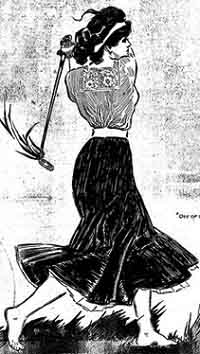 what hopes to be trails meekly and blushingly behind her over the links wondering irascibly what the dickens has gotten into the women, anyway.
what hopes to be trails meekly and blushingly behind her over the links wondering irascibly what the dickens has gotten into the women, anyway.
The pretty barefoot enthusiasts are to be found almost any morning at many golf clubs. With the dawn they come sprinting over the grass from all directions, bright eyed and eager for the morning’s sport. Nearly all are attended by some devoted though irascible man who is so sleepy that he can hardly walk and whose dull mind fails to comprehend why chasing barefoot over wet grass after a small ball is of sufficient interest to draw one from a comfortable bed where for at least three hours more one might sleep and – O-ho-ho.
“Stop yawning, John,” says milady, severely. “What in the world is the matter with you? Why, I was never wider awake in my life. Isn’t this morning air delightful? And look at the dew on the grass. I never knew that mornings were so beautiful.” “Wish you’d never found it out,” grumbles the unreasonable man. But milady, being used to John, only smiles sweetly and goes her way.
Those women who live within walking distance of the links usually walk from home barefoot. Those, however, who are obliged to avail themselves of transportation are obliged to conform to the requirements of conventionality for a certain length of time; but when the links are reached – away with the confining shoes and clinging stockings. A quick exit is made to some secluded spot, shoes and stockings are disposed of and when there comes a reappearance all is there but the pedal coverings and they are conspicuous by their absence. […] the younger generation, shamelessly flaunts its uncovered toes, snaps its fingers in the faces of the critical and sprints along – barefoot.’ (Chicago Tribune, August 1909)
Jumping Rope
‘Skipping a rope is Diana’s newest diversion. It will turn her into a radiant being and make her fascinating forever […] a young and beautiful matron […] made her first attempt at the exercise on the green lawn of her cottage and her husband turned the rope. The lady appeared in a gown with sweeping skirts, gathered them up on both sides and jumped for five minutes, with swish and flash of the riches lace lingerie and delicate transparent hosiery.
The performance shocked some of the “grave and reverend seigniors” who resided near. One lady, who was on her veranda when the exercise began, beat a hasty retreat to the house, with her group of children, and pulled down the shades’ (Los Angeles Herald, 1903).
The Edwardian Bowling Girl
‘In days of old my Lady Prudence, dainty in her dimity, demure in her excitement, leaned over garden balconies and discreetly applauded the frilled-shirt gentlemen who stoutly bowled at the pins set on the shaven green. But my lady of these later days is no longer content with these shy athletics. Now the gentlewomen substitute cheviot shirt waists for muslin frocks, golf skirts for crinoline, natty stocks for lace frills. They no longer clap their mits from balconies above the bowling green, but come swinging into the polished 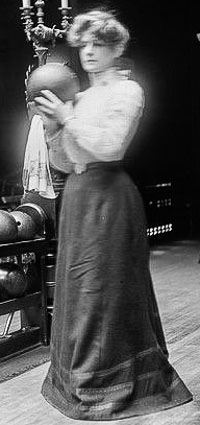 magnificence of the athletic clubs and rival the men with the smooth grace that so frequently ends with the triumphant clatter of a “spare” at candle pins.
magnificence of the athletic clubs and rival the men with the smooth grace that so frequently ends with the triumphant clatter of a “spare” at candle pins.
From my Lady Prudence, who tiptoed with excitement at the swing of some ruffled gallant, to our modern maiden’s ball which spins down the alleys, there lies the happy change from Samuel Richardson’s heroines, who fainted promptly at a man’s glance, to Dana Gibson’s athletic girl, who rivals on the alley the brawny, flannel-clad young gallant, who bowls the harder because this young lady of the alley bowling beside him has just made a “strike” with graceful strength. Bowling is the real fad of the girl of today, and she bowls as she does everything else, remarkably well.
Bowling is a fine exercise. The muscles of the back become stronger and the exercise straightens the spine, because the muscles each side of the spine act together and pull the spine into proper position. The shoulder blades become flattened in the same manner. The arm muscles are exercised in swinging the ball and in balancing the body. There is, of course, danger of over-development of one arm. The wrist becomes stronger from the movement of holding and swinging the ball. […] The legs are exercised in the run and slide that most players take before releasing the ball from the hand. In fact, the whole body seems to partake in the movements of bowling. The abdominal muscles are exercised so much that the flesh there is reduced. It makes one graceful, for it requires control of the muscles and coordination to run and slide and deliver the ball in a straight line. […]
there is a great rivalry among the women at these bowling parties. Clubs of men and women meet together and bowl for an hour or two, and then have coffee and sandwiches served to them or they go to a hotel and enjoy a good supper. […]
The correct costume for evening bowling is a tailor-made white cheviot shirt waist, with white or colored stock, golf skirt and thick low shoes. Evening dress is never worn for bowling. In the daytime colored waists are worn instead of white […] their sleeves rolled up, showing the rounded muscle that the exercise has given them.’ (Los Angeles Herald, 1903)
‘Any dress that gives you perfect freedom will do for bowling. Either a shirt waist or a sweater is comfortable; the skirt must be short. A gymnasium shoe, with the sole made to prevent slipping, is used. There is besides a special bowling shoe made of leather, with a horse-hide sole and a rubber tip fastened to the sole across the ball of the foot, to prevent slipping. There can be no true bowling in long skirts and tight corsets.’ (Los Angeles Herald, 1904)
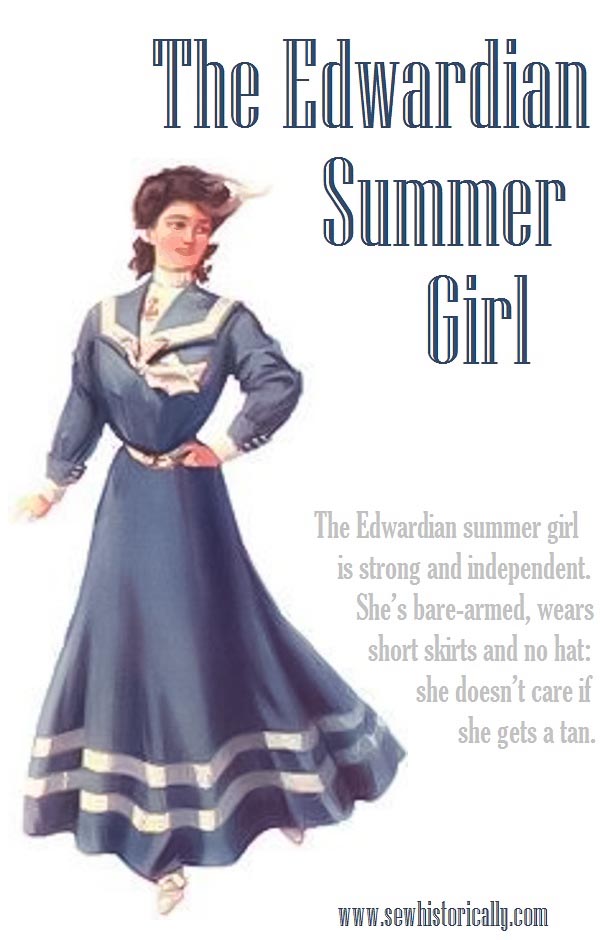
Hello! I found on you a link up party. You’re blog is super fascinating! I’m the founder of my town’s renaissance faire and we do a lot of pirate, steampunk and victorian events as well so I’m totally into historical costuming! I’ve never had the opportunity to dress Edwardian though! If I do, I’ll be sure to check your blog for tips!
http://www.quirkybohemianmama.com/
Thanks, Hollie! 😀
I found this article very interesting. I love furnishing doll houses (using a LOT of scrapcraft) and I got some lovely ideas for dressing dolls. Thank you.
Thanks for stopping by, Kathy! 🙂
Fascinating reads a peek into the past. I am sure only the wealthy women were able to be “meek and ladylike” the every day woman was working. I wonder how much of a fashionable fascade it all was.
Loved reading all the articles, great research in finding them all.
Thanks, Leanna! Victorian women – rich and poor – were supposed to be meek and ladylike, but it was considered old-fashioned in the Edwardian era: Edwardian women should be strong and independent.
Fashion history is very interesting. Thanks for sharing @ Vintage Charm!
Thanks, Cecilia!
Wow, how times have changed! Lina, this history is fascinating! Both for the look of the garments, but also the descriptions. In some ways, I wish we could go back to this, but in most ways…not. Anyway, it’s very interesting! Maybe do some other eras too!
Thanks, Florence!
What an interesting glimpse into the past and how different things were.
Thanks, Elise!
“The sweet, pale, clinging woman has disappeared” cracked me up! I’m pale, like to think I’m sweet, but I’ve never been clinging! 😀 I love seeing the changing styles over the years. I’ll be coming back to this post.
Thanks, Jean! 😀
Love all of the old photos…and love the tie in with fashion…xo
Thanks for sharing at the party – hope to see you at this week’s party: http://www.jodiefitz.com/2017/08/22/reader-tip-tuesday-party-crafts-recipes/
Its still & growing all week :)…
Thanks for stopping by, Jodie!
I adore Edwardian style – so pretty
Thanks, Amber! 🙂
Now I want Armenian combinations! Thanks for this!!
Lol! 😀 Thanks for stopping by!